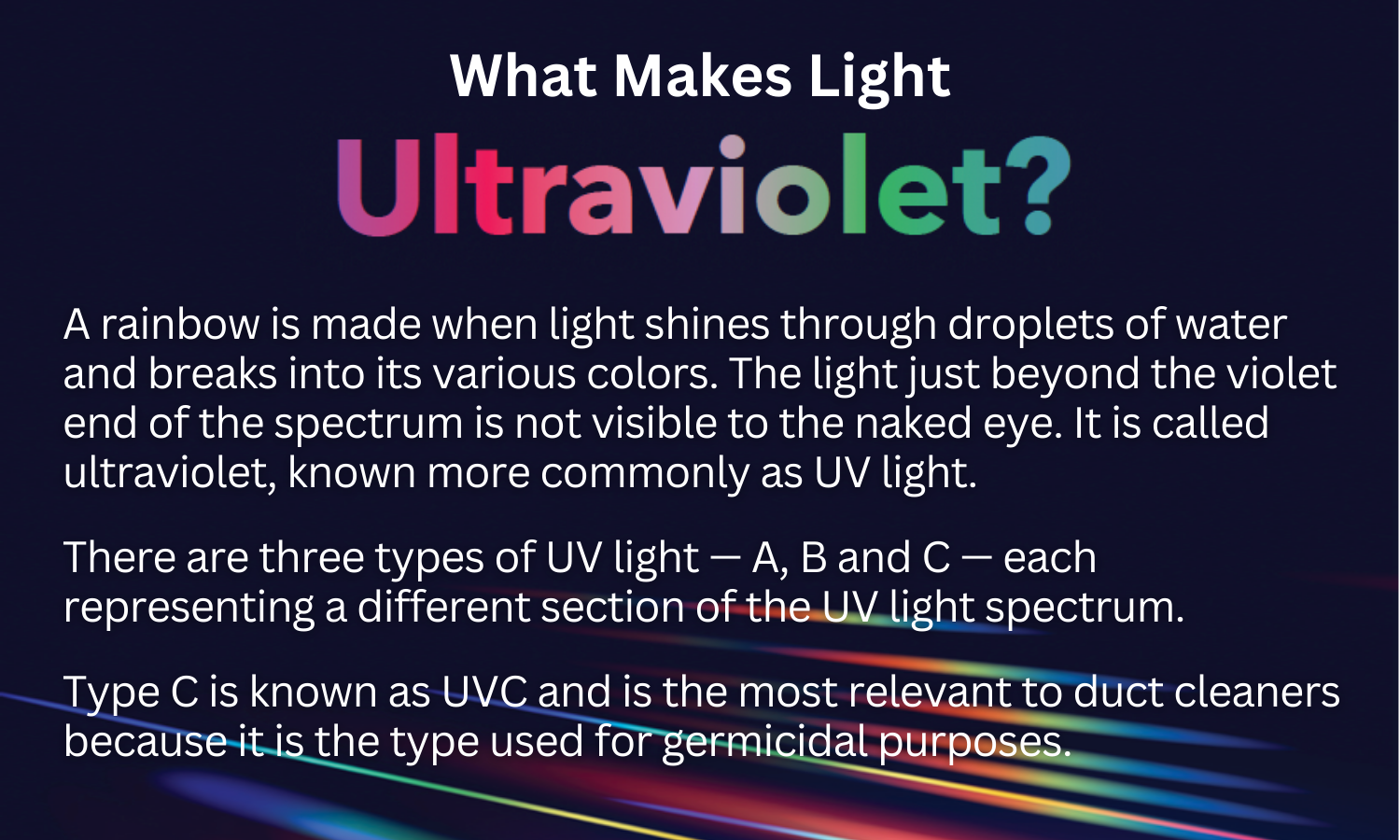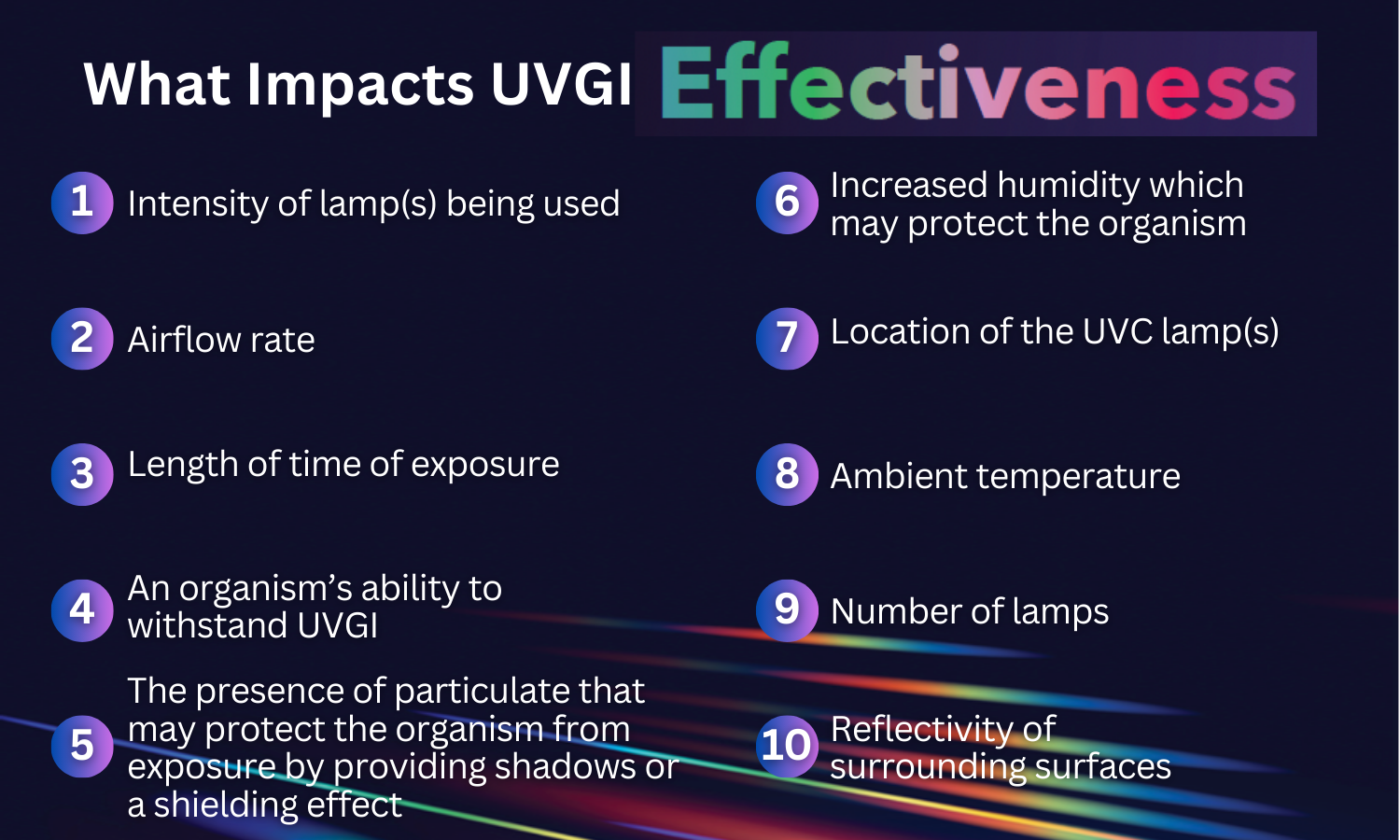Exploring the Application of UV Light in HVAC Systems
With the COVID-19 pandemic and related scientific insights came a renewed awareness of, and focus on, indoor air quality (IAQ). Consequently, more and more individuals are realizing the critical importance of the HVAC systems that supply air to their living and working spaces, and are calling on NADCA members to ensure these systems are clean and operating at peak efficiency.
While no method of duct cleaning is more effective than source removal, it is important that duct cleaners understand the many air-cleaning technologies at a time when HVAC cleaning is figuring so prominently in people’s minds.
One such resource is ultraviolet (UV) lighting.

HOW UV LIGHTING WORKS
UV lighting, when applied to duct cleaning, is known as ultraviolet germicidal irradiation (UVGI). UVGI “deactivates” by making them unable to reproduce or kills microorganisms like viruses, bacteria, molds, and fungi by disrupting their DNA structure. Some organisms deactivate after just microseconds of exposure, while others require much longer periods.
GENERAL USE AND PRACTICES
The most common UV lighting type use in germicidal irradiation is Type C (UVC). When it comes to using these UVC lamps in HVAC systems, placement is everything. A single low-pressure UVC lamp placed randomly in an HVAC system will have little effect. When utilizing UVGI, application will most often come from low-pressure UVC lamps, although, if critical levels of disinfection are required, medium-pressure UVC lamps may sometimes be deployed.
Low-pressure UVC lamps operate best between 72°-105° F and are not operable below freezing temperatures. What’s more, low-pressure UVC lamps have a finite lifespan, and their effectiveness naturally reduces over time, typically needing to be replaced every 1-3 years depending on the manufacturer’s specifications.
It is imperative that all UVC lamps installed in HVAC systems be inspected periodically to ensure their safety and proper function. Any dirty lamps will result in reduced effectiveness and should be cleaned according to manufacturer's instructions. Always bear in mind that the improper placement of UVC lamps can lead to both poor efficiency and significant hazards. As such, it’s recommended that anyone installing, or aiming to install, UVC lamps in HVAC systems be comprehensively educated on the topic and related issues.
POTENTIAL HAZARDS
Component Decomposition
Due to its potency, UV light can severely degrade organic materials over time in an HVAC system. Components it can damage include filters, sealants, gaskets, and wiring insulation. This can lead to air leaks, fire hazards and a general loss of system performance.
If one opts to install UVC lamps, any vulnerable component materials should be shielded or substituted. If there if any question as to whether a particular material is vulnerable to decomposition by UVGI, keep in mind that it is always best to consult the manufacturer of the material in question.
Human Exposure
UVC exposure can be extremely harmful and should always be taken seriously. Workers should not be subject to direct UV exposure and all UVC lamps should be powered off following lockout/tagout procedures when they are being serviced. If for some reason UVC exposure is unavoidable, the ASHRAE Handbook states, “personnel should wear protective clothing (no exposed skin), protective eyewear and gloves. Most eyewear, including prescription glasses, are sufficient to protect eyes from UV, but not all offer complete coverage; standard-issue protective goggles may be the best alternative.”
Mercury Exposure
UVC lamps use a bulb that is referred to as a compact fluorescent lamp (CFL). Because CFLs contain a small amount of toxic mercury, if a bulb breaks, care must be taken to reduce exposure.
Ozone Generation
Ozone is produced at a wavelength of 185 nanometers. To avoid ozone production, always use UVC lamps with a wavelength of 254 nanometers.
MOVING FORWARD
While the application of UVGI and installation of UVC lamps certainly merit consideration, it continues to be the industry consensus that source removal of contaminants remains the single best method for cleaning and decontaminating HVAC systems. That said, the application of UVGI in HVAC systems can be an effective means to reduce airborne pathogens; however, only if UVC lamps are properly and strategically installed in sufficient number and/or intensity and properly maintained.
Remember that if you do choose to install UVC lamps, it’s critically important that you are well-trained, educated in all requisite materials and always conscious of the potential pitfalls and hazards of this method.

This article originally appeared in the July/August 2023 edition of DucTales.
MORE WAYS TO EARN CECs:
NADCA offers members an easy way to earn continuing education credits (CECs). Just read a designated article in DucTales magazine and complete an online quiz.
HINT: The article above first appeared in DucTales, and is worth one (1) CEC!!
Here’s how to take advantage of this benefit:
- Read the article above.
- Visit nadca.com/education/ductales-quizzes and log-in to purchase and complete the CEC quiz.
- Pass the CEC quiz and earn your credit.
This exclusive benefit is only available to NADCA members.
